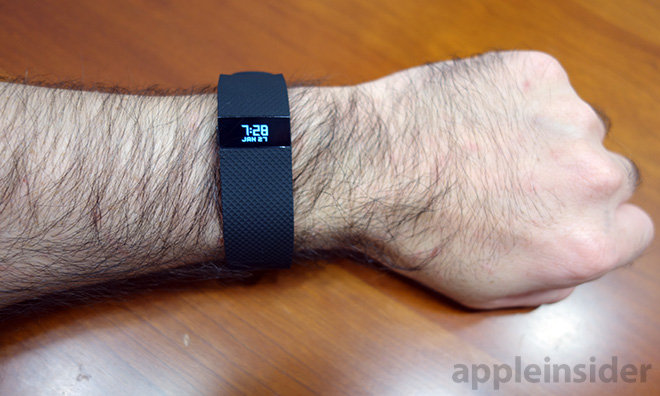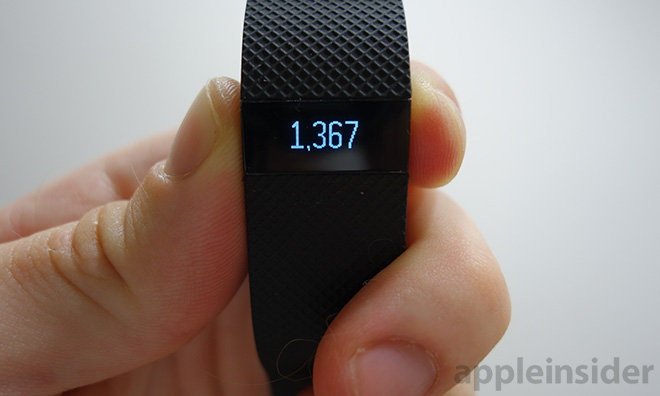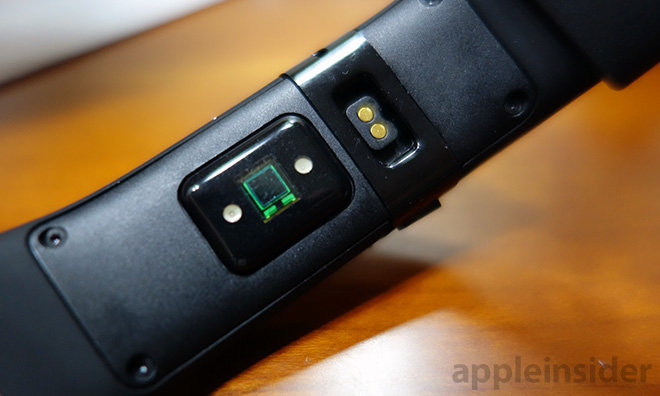Fitbit's new Charge HR fitness band puts an emphasis on wearability with a slim and light form factor, but maintains a wealth of health tracking features including a real-time heart rate sensor and onboard display.
Part of the company's 2015 product lineup, Charge HR builds on last year's Flex fitness band with a bright blue OLED display, advanced sensor package with altimeter for counting stairs climbed and optical heart rate monitor dubbed "PurePulse."
Compared to older Fitbit models, the most prominent addition is a small but crisp OLED display, which lets users keep track of steps taken, resting heart rate, calories burned and even incoming calls. Pressing the multifunction button seated just left of the display turns it on, while multiple presses cycle through menu options configurable via the Fitbit iOS app or Web tool.
Unlike other devices in Fitbit's stable, Charge HR comes with a proper buckle strap made of flexible elastomer for a comfortable, yet secure fit. Not only does this design allow for a more customized fit, but it keeps the optical heart rate sensor in constant contact with your skin for accurate readings.
So far, the device has been able to consistently find and monitor our pulse, a task made difficult by a forest of thick arm hair. Other optical systems have failed in the past and electrode-based sensors are particularly ill-suited for our specific needs. The Charge HR's ability to read through the "noise" is a testament to its design.
With Charge HR's real-time heart monitoring capability, users can check if they're in fat burn, cardio or peak zones when exercising (taken in continuous one-second intervals) as denoted by three special heart icons displayed next to the pulse rate readout. Alternatively, the device takes readings at five-second intervals throughout the day and plots results on a line graph for later perusal. Personalized zones can be tweaked via the iOS app and uploaded to Charge HR.
Sleep tracking is moving closer to becoming a standard feature for fitness trackers and Charge HR is no exception. Not much has changed from models like the Flex, but Fitbit built in new algorithms that automatically determine when a user falls asleep, supposedly delivering more accurate data for sleep trend computation. Vibration alarms can also be set through the iOS app.
Fitbit puts battery life at around five days of normal use with two-hour charge times, but real world results could be less depending on how often you check your heart rate, activate the display or sync the device over Bluetooth 4.0. Charging is accomplished via a specialized plug located on the unit's back, an open design which means Charge HR is only water resistant and can't be worn while swimming.
Finally, users who connect pair Charge HR to an iPhone can see incoming call notifications displayed on their wrist, but functionality is limited. The device vibrates when a call comes in, but users can't dismiss or send the call to voicemail with a click of the button.
Charge HR comes in at $149.95, while a slightly thinner version called Charge ditches heart rate monitoring capabilities and costs $20 less.
AppleInsider will offer a more thorough assessment of Charge HR once we've put it through the paces.
 Mikey Campbell
Mikey Campbell









-m.jpg)






 Marko Zivkovic
Marko Zivkovic
 Christine McKee
Christine McKee
 Andrew Orr
Andrew Orr
 Andrew O'Hara
Andrew O'Hara
 William Gallagher
William Gallagher

 Mike Wuerthele
Mike Wuerthele
 Bon Adamson
Bon Adamson




-m.jpg)



27 Comments
Yeah I have the Charge. It is quite comfortable to wear and also quite accurate, however if you are on an Exercycle on a road to nowhere you won't get any credit for it. Same goes for other non impact activities like Yoga or a Tummy Cruncher session at the gym. I would be interested to see how the HR handled those activities - perhaps the heart monitor would be just the thing. The web interface is good and is handy for competing with friends on steps. Kind of reminds me of the old ''Metro'" style on a Wokia phone. iOS app is also quite good. I use the Exercise Tracking function and it gives you a nice GPS trail of where you have been along with all the usual stats. One little quirk would be the calorie counter. If you stroll along for 30 mins it seems to think you have used more calories than if you went super hard out for 20 mins - purely because it thinks in terms of 3x cals per minute. Also it makes the phone very hot and pulls a fair bit of juice while you are using Ex Tracking. Bottom line, if you are tossing up between the Charge and Charge HR, cough up the extra $20 and go for the HR.
That is one seriously Neanderthal-hairy arm.
The Charge HR is still my first choice for my next wearable… but will hold off until the next ?Watch presentation.
The Charge HR is still my first choice for my next wearable… but will hold off until the next ?Watch presentation.
Agreed. Me too. I'm in the market for an HR monitor for trail running and this does look like an elegant solution. But, I will wait for the AppleWatch.
[quote name="christopher126" url="/t/184600/first-look-fitbit-charge-hr-fitness-band-with-real-time-heart-rate-sensor#post_2669346"]Agreed. Me too. I'm in the market for an HR monitor for trail running and this does look like an elegant solution. But, I will wait for the AppleWatch. [/quote] I had the Fitbit Force. I liked it, but the clasp was shitty. Even with a focused attempt to make sure it was well connected it still fell off within a couple months (right before the recall, actually). This new clasp should be fine. I'm hoping the next ?Watch presentation reveals some new features. If one or more of the following appear I will probably buy ?Watch Sport: [LIST=1] [*] Option to auto-lock iPhone(s), iPad(s) and/or Mac(s) when outside a certain range. [*] Option to auto-unlock Mac(s) when within a certain range inside certain [I]safe[/I] circles, like home. [*] Option to make a sound and/or resonate ?Watch if you move outside your iPhone(s), iPad(s) and/or Mac(s) area in certain environments. (e.g.: forgetting your iPhone as you leave for work, leaving your MacBook Air and backpack behind when you leave a coffee shop.) [*] The S-series SiP will be updatable by a certified Apple Jeweler (or something to that effect). [*] Option to monitor sleep. [/LIST] These are ordered, IMO, from most-likely to least-likely. PS: Begin able to play music from ?Watch with BT headphones is something I'm interested in, but I'm concerned about battery life for both the ?Watch and headphones at this point. I'd have to see this reviewed or have Apple give some stats that make me say "okay" to that. I wouldn't be surprised if we see some new BT headphones from Apple specifically for ?Watch at their next presentation.